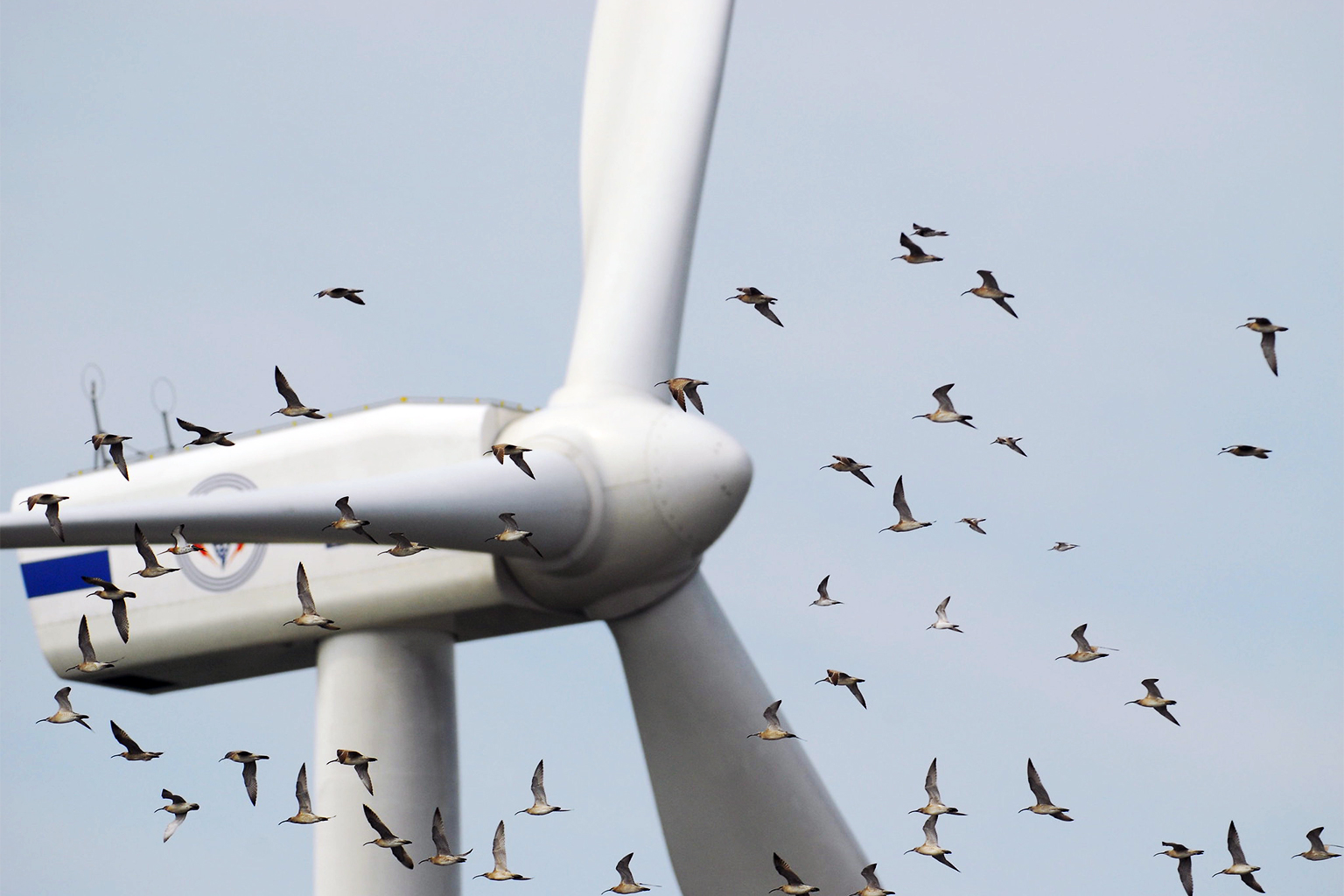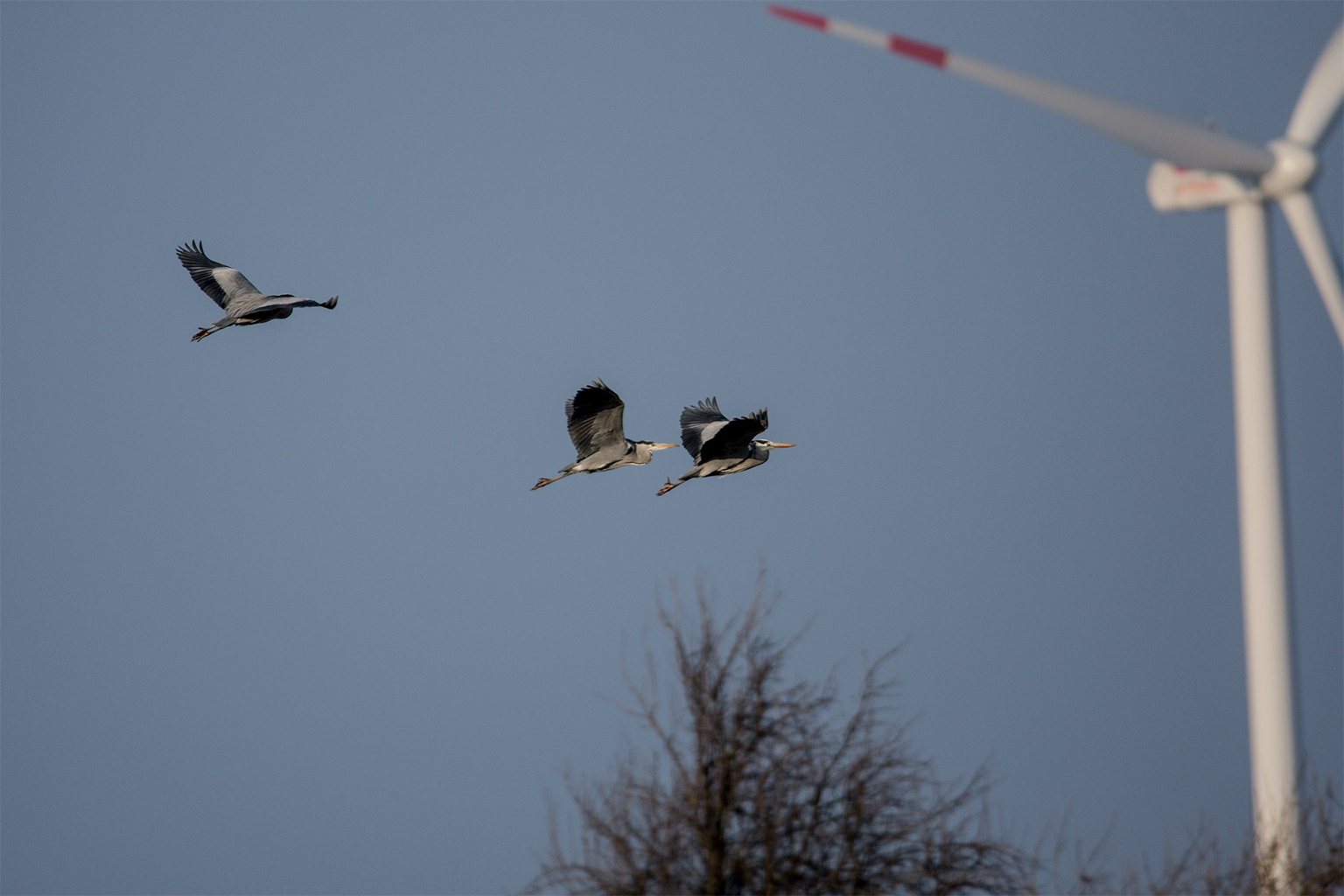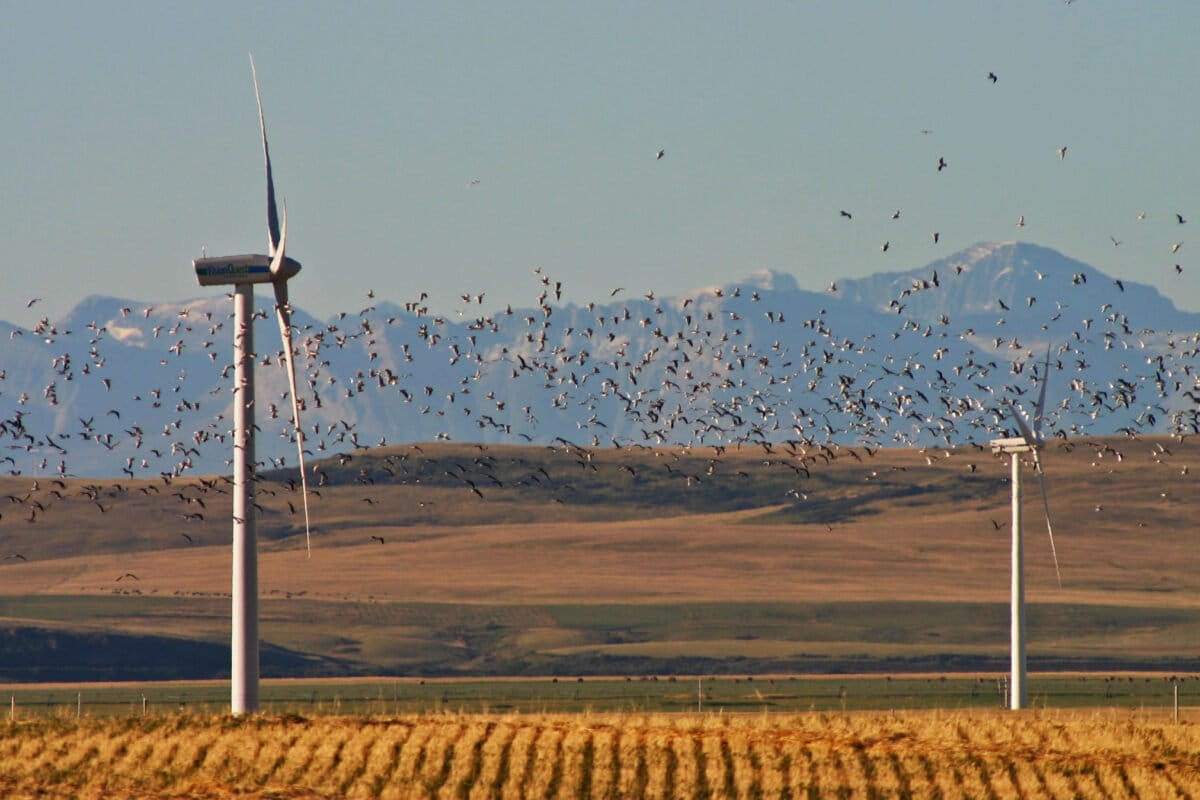- A new study suggests a way to stop seabirds from colliding with wind turbines: painting a black-and-white pattern on all three blades and the pylon to produce a flickering effect.
- This strategy has yet to be tested or implemented, but experts believe it has promise and would create its desired effect.
- However, getting approval for painting wind turbines can be difficult, and this mitigation strategy might generate the unintended effect of displacing seabirds, one expert says.
- It’s estimated that wind turbines kill thousands of birds in the U.K. alone.
Picture yourself driving down a local highway, passing familiar street signs and encountering typical traffic. Then, without warning, you find a cow standing in the middle of the road. You slam on your brakes, but it’s too late to avoid a collision.
Something similar happens to seabirds when they encounter wind turbines, especially when they’re looking down, rather than ahead, in search of food, says Graham Martin, an ornithologist and bird vision expert at the University of Birmingham in the U.K.
“If you’re an eagle and you’re flying along, you may have fantastic, high spatial resolution vision,” Martin tells Mongabay. “But if you turn your head to look down, you just don’t look where you’re going. But of course, that’s always worked [for birds] in the past; that’s never been a problem. It’s just now that we put things in the way for them.”
In a recent paper published in Global Ecology and Conservation, Martin and his colleague, Alex Banks of Natural England, an independent government agency, proposed a new strategy for mitigating collisions between seabirds and wind turbines. It involves painting a black-and-white pattern on turbines to produce a flickering effect while moving, thereby warning birds of a turbine’s existence — and hopefully reducing deaths.


This technique, which has yet to be tested, builds upon an earlier suggestion from a 2020 study of painting one turbine blade black to reduce bird fatalities. Martin says he believes this other technique worked because it also created a flickering effect when the black blade moved in front of the white pylon. However, he says the strategy he proposes in the new paper would generate a more robust signal since all three blades and the pylon would be painted in a black-and-white pattern.
“It will go black, white, black, white as it rotates,” Martin says. “But equally, as the blade goes in front of the pylon … it’ll go black, white, black, white more frequently.”
The U.K. has nearly 11,500 wind turbines, most located on onshore wind farms. However, the government recently proposed a significant expansion of offshore wind farms to produce enough wind capacity to power every U.K. home. Martin says this expansion will bring more seabirds into contact with wind turbines, which is why he and Banks wrote their paper.
It’s estimated that thousands of birds are killed by wind turbines in the U.K. each year, but Martin says it’s hard to get an exact number.
“The rate is very difficult to tell partly because the birds are not coming through at a constant rate, and the weather makes a big difference, so we’re stuck with these very broad estimates that people come out with,” Martin says. “All we do know is that birds do fly into these [turbines].”
He adds it’s also challenging to assess how many seabirds come into contact with wind turbines since collecting their corpses at sea is impossible.

The study suggests that certain seabirds are particularly vulnerable to these collisions, including gulls, eagles, gannets, kittiwakes and skuas.
Rob Simmons, managing director of Birds & Bats Unlimited, a South African company that provides environmental consultations for wind farms, who was not involved in the study, calls the proposed strategy “very clever.”
“If I had carte blanche here, I would recommend this strategy,” Simmons told Mongabay. “Graham [Martin] has done a whole lifetime of assessments of vision in birds, and we would go for his research.”
However, Simmons says it can be difficult to convince authorities to implement such strategies. In South Africa, for instance, he says it took many months of negotiations with the South African Civil Aviation Authority (CAA) to allow the painting of one blade on several existing turbines at a wind farm in Western Cape province, in an effort to protect threatened black harriers (Circus maurus). However, the CAA instructed that only red paint, not black, could be used. So far, managers have painted two turbines and plan to paint another two this year, Simmons says.


Tris Allinson, a senior global science officer at BirdLife International, who advises on wind farm projects but wasn’t involved in the new study, says it makes sense to paint wind turbines according to Martin’s theory. However, he says that such a tactic may unintentionally displace birds.
“That becomes a problem if it’s denying these birds access to important foraging areas or denying them routes that they need to be moving across during their daily movements or their annual migrations,” Allinson tells Mongabay. “So collision is one problem, but displacement is another problem.”
Similar to Simmons, he says getting approval to paint wind turbines can be challenging, especially since they’re designed to be “as unobtrusive visually as they can” to people who don’t want them in their vicinity.
There are other ways to deter birds from flying into wind turbines, the simplest being appropriately planning where to erect wind farms to avoid contact with birds, Allinson says. Some programs also visually monitor areas around wind farms — either with people or by computer — and shut off the turbines when birds come near, which Allinson says is also very effective. For instance, he says planners successfully implemented these strategies at a wind farm project in Egypt as part of the Migratory Soaring Birds Project.
“Hopefully, over time, it’ll become more standard practice,” he says, “and developers will, as a matter of standard practice, use cameras, use painted blades, use all of the mitigation measures that we know, and just do this more as part of the standard process of doing nature-safe wind energy.”
Elizabeth Claire Alberts is a senior staff writer for Mongabay. Follow her on Twitter @ECAlberts.
Banner image: Birds flying through wind turbines. Image by David Dodge, Green Energy Futures via Flickr (CC BY-NC-SA 2.0).
Citations:
Martin, G. R., & Banks, A. N. (2023). Marine birds: Vision-based wind turbine collision mitigation. Global Ecology and Conservation, 42, e02386. doi:10.1016/j.gecco.2023.e02386
May, R., Nygård, T., Falkdalen, U., Åström, J., Hamre, Ø., & Stokke, B. G. (2020). Paint it black: Efficacy of increased wind turbine rotor blade visibility to reduce avian fatalities. Ecology and Evolution, 10(16), 8927-8935. doi:10.1002/ece3.6592
